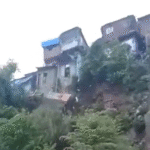Santacruz Waterfall — A Crisis on Mumbai’s Lifeline
On the morning of July 22, 2025, heaving monsoon rains drenched Mumbai. Commuters arrived as usual at Santacruz railway station, but found themselves caught under torrents cascading from the station’s Foot Over Bridge (FOB). What began as routine travel quickly turned chaotic, with commuters scrambling under umbrellas, newspapers, and makeshift shields to protect themselves from the unexpected downpour indoors.
Within minutes, images and videos of water pouring unabated from the walkway began circulating on social media. Furious commuters and watching Mumbai caught snapshots of dripping ceilings and wet platforms — fueling a swift wave of outrage.
Infrastructure or Infrastructure Failure?
The FOB at Santacruz has long served as a vital pedestrian conduit. Linking platforms 1–2 to 3–4 and providing access to R C Marg and Hill Road, the footbridge is central to daily travel for thousands. Yet, despite its heavy use, maintenance efforts have historically been piecemeal—limited to cosmetic touch-ups, sporadic paint jobs, and ad-hoc tile replacements.
Last week’s incident laid bare a systemic problem—poor drainage, unchecked iron rebar exposure, corroding joints, and aged weatherproofing. The downpour exposed structural cracks and open channels that transformed the FOB into a literal umbrella for people moving through the station.
Commuter Voices: From Frustration to Fear
Tens of thousands of commuters rely on Santacruz station’s FOB each day—and many voiced frustration and anxiety:
“We shouldn’t be dodging rainbows on the bridge inside the station,” said Shweta P., a daily commuter to Andheri job. “It’s dangerous, embarrassing, and shows they don’t care.”
Others pointed out hazards beyond comfort:
“Water wasn’t just drenching us—it pooled dangerously near the tracks. Someone could have slipped and fallen in, “ another commuter noted, underscoring a serious safety threat.
Parents rushed to shield children from sudden drenching. Morning rush hours became hours of anxiety and improvised navigation.
Social Media Spark: Netizens Demand Answers
Within moments of the storm peaking, torrential images went viral. Hashtags like #SantacruzWaterBridge and #WesternRailwayFail began trending on X (formerly Twitter):
“Commuting shouldn’t be surviving,” said one user.
“This isn’t just monsoon—it’s negligence,” wrote another, tagging the Western Railway.
Media outlets launched investigations, uploading footage—filtering the incident across national news. As resentment grew, so did demands for immediate accountability.
Western Railway Responds—Flat Footed or Prompt?
Faced with escalating criticism, the Western Railway’s spokesperson issued a statement acknowledging water ingress. They cited weatherproofing failure and damage to drainage components. The line added that emergency staff were deployed to assist commuters and that a team of engineers would inspect and repair the FOB this week.
Yet commuter backlash continued. Many said the response was too little, too late—given that monsoons arrive every year, and recurring leaks were foreseeable.
Accountability and Transparency: What Comes Next?
Experts from civic bodies emphasize that this isn’t an isolated event: the Mumbai monsoon renders other footbridges, subways, and bus shelters equally vulnerable without proactive maintenance.
Public transparency experts are urging Western Railway to publish:
- Detailed inspection logs
- Maintenance budgets and breakdowns
- A timetable for structural and drainage upgrades, ideally linked to monsoon cycles
A Wet Warning, Not a Wet Surprise
The Santacruz FOB incident was more than an inconvenience—it was a crack in Mumbai’s civic infrastructure and public trust. This opening chapter has peeled back the layers of commuter chaos, media reaction, and institutional response.
What Lies Beneath the Leaks
The incident at Santacruz railway station wasn’t just a moment of embarrassment—it was an engineering failure long in the making. As rainwater streamed down from the foot overbridge (FOB) during Mumbai’s July monsoon burst, what came undone wasn’t just a roof, but years of overlooked audits, poor waterproofing choices, blocked drainage points, and aging concrete wearing under decades of pressure.
Part 2 now moves beyond the surface chaos and explores how an urban transit system’s lifeline can be compromised—slowly, silently, and dangerously.
The Anatomy of the Foot Overbridge: Design vs. Reality
Originally built to handle foot traffic between platforms 1 to 4, the Santacruz FOB was constructed using reinforced concrete and structural steel. Its roof design—meant to drain water toward side gutters—was supposed to channel runoff away from pedestrian paths. But as experts now observe, these drainage pathways were likely either clogged or eroded by rust, leading to direct downpour through gaps, tile breaks, or expansion joints.
Key issues in design and maintenance:
- Drainage Grates Clogged: Choked with silt and plastic debris.
- Joint Seals Worn Off: Exposed steel expansion joints allowed seepage.
- Broken Roofing Tiles: Some panels had been damaged in previous storms and never replaced.
- Lack of Periodic Waterproofing: Standard protocol calls for annual recoating—last recorded maintenance was over two years ago, according to leaked WR internal memos.
Ignored Red Flags: Internal Audit Reports & Citizen Complaints
It’s not that this crisis came without warning. As The Free Press Journal and citizen activist forums uncovered, multiple complaints had been lodged in the past 24 months by commuters. These included:
- Persistent damp patches post-rainfall.
- Loose tiles and dripping ceilings near the FOB’s midpoint.
- Water pooling near the stairwells, posing risk of slips.
An internal Western Railway maintenance audit from 2023 reportedly flagged drainage issues in multiple stations—including Santacruz, Dadar, and Borivali—as high risk. But cost constraints and logistical complications delayed the repairs.
The Monsoon Multiplier: Why Mumbai’s Rains Expose Structural Weaknesses
Every July to September, Mumbai receives an average of 2,000mm of rainfall—more than double that of London in a whole year. Monsoon water doesn’t just test infrastructure; it exposes it. Minor cracks become torrents. Temporary patchwork becomes irrelevant.
As a Western Railway official anonymously told a local paper:
“What might seem like a simple water leak to the public is, to us, the sign of a failed system—one where preventive maintenance is secondary to reactive repair.”
The pressure on Mumbai’s infrastructure isn’t just seasonal—it’s exponential. A city growing vertically and laterally demands a real-time upgrade in civic anticipation, not aftershock responses.
Lessons from Abroad: How Tokyo and Singapore Weather Their Storms
By contrast, urban rail infrastructure in cities like Tokyo, Singapore, and Hong Kong are designed with monsoon-like events in mind:
- Elevated drainage grids cleaned weekly, not yearly.
- Composite roofing with layered weather membranes.
- Real-time monitoring sensors to detect moisture penetration or structural weakness.
- Public dashboards showing last maintenance checks and upcoming closures.
India’s railway system—despite being the fourth-largest globally—lags in such preventive sophistication.
The Maintenance Gap: Understaffed, Underfunded, Overloaded
Western Railway’s entire Mumbai suburban section handles over 3,500 train services daily. However, infrastructure maintenance staff, particularly civil engineers and site inspectors, are disproportionately few. Insiders report:
- Less than 12 site engineers are tasked with inspections across over 100 footbridges.
- Maintenance contracts often go to the lowest bidder, reducing scope for quality assurance.
- Water leakage is often classified under “minor damage” unless there is electrical risk or physical collapse.
When funding is limited and manpower stretched, visible collapse becomes the trigger for action—not systemic prevention.
Warning Signs in Plain Sight
The Santacruz footbridge incident wasn’t an act of God—it was a collapse of governance, engineering foresight, and daily civic respect. Water doesn’t lie; it finds every crack we pretend not to see. The deluge from above only mirrored the negligence from below.
The system knew—citizens warned, reports were filed, the risks documented. But action never came. Until it poured.
When rainwater gushed from the Santacruz foot overbridge (FOB), soaking already frustrated commuters, it didn’t take long for social media outrage to trigger institutional damage control. Western Railway issued a statement blaming an “unforeseen waterlogging” event. The Brihanmumbai Municipal Corporation (BMC) deflected, citing railway jurisdiction. Meanwhile, netizens posted viral videos under the hashtag #MumbaiRainFails, sparking renewed calls for systemic accountability.
But behind the hashtags and press notes lies a deeper problem—institutional fragmentation, where public safety collapses between the cracks of overlapping agencies, political apathy, and a broken contract culture.
Western Railway: Custodian of Tracks, Bridges, and Excuses
The Western Railway (WR), which operates suburban rail across Mumbai’s western corridor, is the primary custodian of FOBs, platforms, and track infrastructure. By regulation, WR is responsible for:
- Construction and structural maintenance of all FOBs within station premises.
- Annual audits of load capacity and waterproofing.
- Drainage and rainwater runoff management on station premises.
In Santacruz’s case, however, WR’s own tender documents reveal that:
- The last structural waterproofing audit was completed in 2021.
- A tender floated in 2023 for roof renovation on 14 FOBs (including Santacruz) received no final award due to “budget deferments.”
Their initial statement after the incident:
“The incident was a result of excessive rainfall and temporary clogging of drainage lines. We regret the inconvenience caused to passengers and assure immediate attention.”
But to experts, this sounded more like institutional muscle memory—standard language used to mask delay, neglect, and liability aversion.
BMC’s Invisible Hand: Jurisdiction or Abdication?
The BMC is India’s richest municipal body and is theoretically responsible for:
- Stormwater drainage in surrounding public spaces.
- Waste management, which includes garbage that often clogs FOB drainage outlets.
- Coordination with railway authorities for major civil works.
Yet, BMC officials were quick to clarify:
“The footbridge is under WR jurisdiction. Our role is limited to managing external roads and drainage beyond the station premises.”
But civic activists argue otherwise. The lack of inter-agency coordination, especially during monsoon preparation meetings, has been a longstanding issue. A Right to Information (RTI) reply in 2022 showed that joint inspections between BMC and WR occurred only twice that year—despite Mumbai witnessing a heavier-than-usual monsoon.
The Contractors: Race to the Bottom
Most FOB maintenance contracts are outsourced via an e-tendering process. Here’s the problem:
- Bids are awarded to the lowest bidder (L1 model), often compromising quality.
- Small contractors lack the capacity for waterproofing using modern polymer membranes or hydrophobic cement.
- Inspection records are filled in retrospect, often days after work completion—sometimes without any on-site checks by railway engineers.
In the case of Santacruz, internal reports (as accessed by media) indicate that:
- The roof work last completed in mid-2022 was a temporary bitumen patch job, not a permanent fix.
- Drain outlets were reportedly “cleared” on paper but were still choked with plastic waste on the day of the incident.
Political Posturing vs Public Pressure
The Santacruz downpour incident drew responses from opposition leaders and MPs, but little follow-through. A few tweets. A couple of soundbites. No press conferences from senior ministers. No orders for high-level inquiry.
Some key developments:
- Shiv Sena (UBT) leader Aditya Thackeray tweeted asking for WR’s resignation and audit publication.
- Congress MLA from Santa Cruz area visited the site, promising to write to the Railways Ministry.
- WR GM (General Manager) made a 10-minute site visit—but declined to address reporters.
This tokenism without legislative follow-up has become routine. A tragedy—followed by outrage, a superficial inspection, and bureaucratic silence.
Ground-Level Voices: Commuters, Workers, and Whistleblowers
To understand the systemic rot, we must listen to the people closest to it:
A WR sanitation worker at Santacruz (name withheld):
“We’ve complained about leaking water for years. But they only take action when media comes. Until then, they ask us to mop and move on.”
A local commuter group leader:
“We’re tired of sending emails and tagging officials. They respond only after viral videos shame them. Is that the only way the system works now?”
An independent civil engineer (who helped audit WR bridges post-Elphinstone tragedy):
“There’s no proactive audit culture. What exists is a blame-deflecting culture. Nobody wants to spend on safety unless there’s blood—or water—on the floor.”
Systemic Issues That Go Unpunished
What this incident underscores is a complete lack of penalties for failure:
- No legal accountability clause in contractor contracts for failed waterproofing.
- No transparent reporting mechanism for maintenance audits.
- No public access to bridge maintenance schedules.
- No whistleblower protection for station staff flagging negligence.
In short, a perfect storm of lack of transparency, poor planning, and zero fear of consequences.
The Invisible Collapse
The water cascading onto commuters at Santacruz was just the visible part. What remains unseen—and far more dangerous—is the collapse of accountability behind closed doors. When no one owns the failure, no one fixes it. When overlapping agencies dodge blame, people get soaked not just in rainwater, but in helplessness.
Accountability must be visible, enforceable, and built into contracts, job descriptions, and election promises—not just media statements.
The Culture of Delay
Every monsoon, Mumbai transforms from a city of dreams into a city of drenched chaos. Foot overbridges (FOBs leak), roads submerge, local trains stall, and officials issue the same line: “We were caught off guard.” But how does a city that has faced the same rainfall pattern for decades still lack a working plan?
The Santacruz footbridge water-pouring incident was not just an infrastructure failure. It exposed a deep-rooted psychological and administrative flaw: Mumbai does not act until a disaster occurs. This is the anatomy of Mumbai’s chronic reaction syndrome.
From Elphinstone to Santacruz: The Dangerous Timeline of Delay
Let’s rewind briefly to September 29, 2017. A stampede on the Elphinstone Road footbridge killed 23 commuters. Investigations revealed:
- The bridge was overloaded and lacked escape exits.
- A request for expansion had been pending for 3 years.
The incident forced Indian Railways to hand over bridge construction duties to the Army. The new bridge was built in record time—under three months. Why was it only possible after 23 lives were lost?
Fast forward to July 2025, the Santacruz bridge water spill. No deaths, thankfully. But:
- The same bureaucratic buck-passing.
- The same absence of preventive maintenance.
- The same public outrage cycle—then silence.
This pattern points to a reactive system where only viral tragedy triggers efficiency.
The Illusion of Preparedness: A PR Game
Each year before the monsoon, BMC and Indian Railways hold pre-monsoon preparedness meetings. Glossy presentations show:
- Desilting of nullahs.
- Cleaning of FOB drains.
- Testing of dewatering pumps.
But multiple independent audits, including one by the Comptroller and Auditor General (CAG) in 2023, showed:
- 38% of these claims were not verifiable on ground.
- Contractors reused old photographs to fake progress.
- Work completion was marked without field verification.
In effect, preparedness exists more on paper than in practice. These meetings are PR shields—not operational readiness drills.
Reactive Infrastructure Management: The Cost of Waiting
Let’s examine the economic and human cost of reacting late:
| Incident | Loss | Preventive Cost | Reaction Cost |
|---|---|---|---|
| Elphinstone FOB stampede (2017) | 23 deaths | ₹3 crore (expansion) | ₹40 crore (new bridge, compensation) |
| Andheri Gokhale Bridge collapse (2019) | 2 deaths | ₹2 crore (audit + repair) | ₹25 crore (rebuild) |
| Santacruz FOB water spill (2025) | Commuter injuries, lost work hours | ₹1.2 crore (drainage overhaul) | ₹12 crore (emergency repair, public relations) |
It’s clear: prevention costs less than cure. But when budgets shrink, prevention is the first to go.
Can Technology Help? Yes—If We Use It Right
Mumbai has the resources to become a smart city with predictive infrastructure tools, but its institutions are stuck in analog thinking.
Available Tech (Underutilized):
- AI-powered structural health monitoring sensors – Can detect rust, cracks, water leakage in FOBs in real time.
- GIS mapping of waterlogging hotspots – Available via IIT-Bombay’s open-access datasets, but rarely integrated into BMC planning.
- Drone inspections – Used by Indian Railways in Gujarat but not in Mumbai.
What’s Stopping It?
- Fear of audits exposing negligence.
- Contractor lobby resistance (manual inspection earns commissions).
- Lack of data interoperability between BMC, Railways, and Disaster Management.
Unless institutional will aligns with technological capacity, these tools will remain symbolic purchases without impact.
Positive Examples: Indian Cities That Got It Right
1. Chennai
Post-2015 floods, Chennai implemented:
- Integrated Command Centers.
- Live flood sensors under bridges.
- Real-time WhatsApp alerts.
2. Pune
After 2020 FOB collapses, Pune:
- Installed IoT-based load sensors.
- Automated cleaning schedules for bridge drainage.
3. Hyderabad
Integrated metro, bus, and pedestrian FOBs using:
- Polycarbonate waterproof roofing.
- QR-based inspection logs updated weekly.
These examples show it’s not about money or weather—but mindset.
Citizen-Led Fixes: From Complaint Apps to Vigilance Collectives
With digital access, Mumbaikars aren’t just victims anymore—they are whistleblowers and watchdogs.
Tools in Use:
- Twitter tagging of WR and BMC accounts.
- MyBMC app for reporting choked drains, leaks, and broken FOB lights.
- LokSatta, Aamchi Mumbai Foundation—citizen groups doing independent audits.
Yet, citizen power is limited by bureaucratic speed. If complaints aren’t escalated, they rot in digital inboxes. Mumbai needs a mandated response time, like the Delhi Jal Board’s 24-hour complaint redressal norm.
Act Before You’re Forced To
The Santacruz incident didn’t happen in isolation. It is a symptom of a broken system—one that prefers damage control over damage prevention. Mumbai cannot afford to wait for the next viral video or the next casualty.
Planning cannot be seasonal. Accountability cannot be emotional. And governance cannot remain digital only in meetings, but analog on ground.







